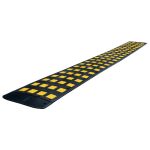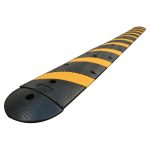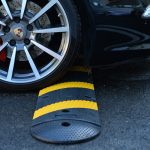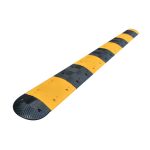The background of the implementation and effectiveness of speed bumps in road safety is an important aspect to consider. Speed bumps, also known as speed humps or speed breakers, are physical traffic calming devices designed to reduce the speed of vehicles on roads. They are typically installed in areas where speeding is a concern, such as residential neighborhoods, school zones, and parking lots. The main purpose of speed bumps is to improve road safety by forcing drivers to slow down and be more cautious. Studies have shown that speed bumps can effectively reduce vehicle speeds and decrease the likelihood of accidents, particularly in areas with high pedestrian activity. However, there are also some drawbacks to the use of speed bumps, such as increased noise and discomfort for drivers and potential damage to vehicles. Therefore, it is important to carefully consider the implementation and placement of speed bumps to ensure their effectiveness in promoting road safety.
Importance of road safety
Road safety is of utmost importance in today’s fast-paced world. With the increasing number of vehicles on the roads, it is crucial to implement effective measures to ensure the safety of all road users. Speed bumps play a significant role in enhancing road safety by reducing the speed of vehicles, especially in areas with high pedestrian activity or near schools and residential areas. These physical traffic calming devices force drivers to slow down, promoting safer driving habits and reducing the risk of accidents. By emphasizing the importance of road safety and implementing speed bumps strategically, we can create a safer environment for everyone on the roads.
Speed Bumps: Definition and Types
Definition of speed bumps
Speed bumps, also known as speed humps or speed breakers, are traffic calming devices designed to reduce vehicle speeds and enhance road safety. They are typically constructed of raised sections of pavement or concrete, strategically placed along roadways to slow down vehicles. The primary purpose of speed bumps is to force drivers to reduce their speed, especially in areas where pedestrian or vehicle safety is a concern, such as near schools, residential areas, or parking lots. By creating a physical barrier that requires drivers to slow down, speed bumps help to prevent accidents, discourage reckless driving, and promote a safer environment for all road users.
Different types of speed bumps
Different types of speed bumps are used in road safety measures to control vehicle speed and improve overall traffic safety. One common type of speed bump is the traditional speed hump, which is typically made of asphalt or concrete and has a rounded shape. Speed humps are effective at reducing vehicle speed without causing discomfort to drivers. Another type of speed bump is the speed cushion, which consists of a series of raised sections that allow larger vehicles, such as buses and emergency vehicles, to pass over them without slowing down significantly. Speed cushions are often used in areas where traffic calming is necessary but maintaining traffic flow is also important. In addition to these types, there are also variations of speed bumps designed specifically for certain situations, such as speed tables for pedestrian safety zones. Overall, the use of different types of speed bumps helps to create a safer and more controlled environment on the roads.
Advantages and disadvantages of each type
Speed bumps are a common traffic calming measure that can be found on many roads and parking lots. They are designed to slow down vehicles and improve overall road safety. There are several types of speed bumps, each with its own advantages and disadvantages. One type is the traditional speed bump, which is usually made of asphalt or concrete and has a rounded shape. These speed bumps are effective in reducing vehicle speed and are relatively inexpensive to install. However, they can cause discomfort to drivers and passengers, especially if the vehicle is traveling at a high speed. Another type is the speed hump, which is longer and flatter than a traditional speed bump. Speed humps are designed to allow vehicles to pass over them at a higher speed while still reducing speed. They are less jarring to drivers and passengers but may not be as effective in slowing down vehicles. Overall, the advantages and disadvantages of each type of speed bump should be carefully considered when implementing road safety measures.
Implementation of Speed Bumps
Factors to consider when implementing speed bumps
When implementing speed bumps, there are several important factors to consider. Firstly, it is crucial to assess the traffic volume and speed in the area where the speed bumps will be installed. This information will help determine the appropriate height and spacing of the bumps to effectively slow down vehicles without causing excessive discomfort to drivers. Additionally, the road conditions and layout should be evaluated to ensure the speed bumps can be safely integrated into the existing infrastructure. Furthermore, it is essential to consider the impact on emergency vehicles and public transportation routes, as speed bumps may affect response times and travel efficiency. Lastly, community engagement and feedback should be sought to ensure that the implementation of speed bumps aligns with the needs and preferences of local residents. By carefully considering these factors, the implementation of speed bumps can contribute significantly to improving road safety and reducing speeding in the area.
Design and placement guidelines
Design and placement guidelines play a crucial role in the implementation and effectiveness of speed bumps in road safety. These guidelines ensure that speed bumps are strategically placed in areas where they can effectively slow down vehicles and reduce the risk of accidents. The design of speed bumps is also important as it should be able to effectively slow down vehicles without causing discomfort or damage. By following these guidelines, road authorities can ensure that speed bumps are optimally designed and placed to enhance road safety for both drivers and pedestrians.
Costs and maintenance considerations
Costs and maintenance considerations play a crucial role in the implementation and effectiveness of speed bumps in road safety. While speed bumps have proven to be an effective measure in reducing vehicle speed and enhancing pedestrian safety, they also come with certain financial implications. The initial installation cost of speed bumps includes materials, labor, and equipment, which can vary depending on the size and design of the bump. Additionally, regular maintenance is required to ensure their functionality and durability. This includes periodic inspections, repairs, and repainting. It is important for authorities to carefully assess the long-term costs and allocate sufficient budget for the installation and upkeep of speed bumps to maximize their benefits in promoting road safety.
Effectiveness of Speed Bumps
Reduction of speed and accidents
One of the key benefits of implementing speed bumps is the reduction of speed and accidents. Speed bumps are designed to slow down vehicles, forcing drivers to decrease their speed. This reduction in speed significantly reduces the likelihood of accidents, as it provides drivers with more time to react to unexpected situations. By effectively slowing down traffic, speed bumps contribute to creating safer road conditions for both drivers and pedestrians. Studies have shown that the presence of speed bumps can lead to a substantial decrease in the number of accidents and injuries on roads. Therefore, incorporating speed bumps as a road safety measure is an effective strategy to promote safer driving and prevent accidents.
Impact on traffic flow
Speed bumps have a significant impact on traffic flow. These physical road features are designed to slow down vehicles, forcing drivers to reduce their speed. As a result, the flow of traffic is disrupted, leading to congestion and delays. While speed bumps are effective in reducing vehicle speeds and improving road safety, they can also have negative consequences on traffic flow. The presence of speed bumps often leads to frequent braking and acceleration, causing a stop-and-go pattern of movement. This not only increases travel times but also contributes to increased fuel consumption and emissions. Therefore, while speed bumps play a crucial role in promoting road safety, their implementation should be carefully considered to minimize their impact on traffic flow.
Public opinion and acceptance
Public opinion and acceptance play a crucial role in the implementation and effectiveness of speed bumps in road safety. While some individuals view speed bumps as an inconvenience and an unnecessary hindrance to their daily commute, others recognize their importance in reducing speeding and promoting safer driving habits. The acceptance of speed bumps by the public is often influenced by their perception of the severity of the speeding problem in their community and the potential benefits of speed bumps in addressing this issue. Additionally, effective communication and education campaigns can help increase public understanding and support for the installation of speed bumps. Ultimately, public opinion and acceptance are key factors that need to be considered when implementing speed bumps as a road safety measure.
Challenges and Limitations
Negative effects on emergency vehicles
Negative effects on emergency vehicles: One of the major concerns regarding the implementation of speed bumps is the negative impact it has on emergency vehicles. Speed bumps are designed to slow down vehicles and improve road safety, but they can significantly hinder the response time of emergency vehicles such as ambulances and fire trucks. The abrupt deceleration and acceleration required to navigate speed bumps can delay the arrival of emergency services, potentially putting lives at risk. This issue has raised debates about finding alternative solutions that can ensure the safety of both regular motorists and emergency responders.
Potential damage to vehicles
Speed bumps are an effective traffic calming measure that has been widely implemented to enhance road safety. However, one potential concern with the installation of speed bumps is the possible damage they may cause to vehicles. The abrupt changes in elevation can result in wear and tear on the suspension system, tires, and other vehicle components. Additionally, drivers who fail to slow down sufficiently may experience jolts and discomfort, leading to discomfort and potential injuries. It is crucial for authorities to carefully design and maintain speed bumps to minimize the risk of damage to vehicles while still achieving the intended safety benefits.
Inconsistency in speed bump design and placement
Inconsistency in speed bump design and placement is a significant issue that needs to be addressed in order to improve road safety. Currently, there is no standardized design or placement guidelines for speed bumps, leading to a wide variation in their dimensions, shape, and location. This inconsistency not only confuses drivers but also poses a potential hazard as drivers may not anticipate the presence of a speed bump or may not slow down in time. Furthermore, the lack of uniformity in speed bump design and placement makes it difficult for road authorities to effectively enforce speed limits and ensure consistent road safety measures. Therefore, it is crucial to establish clear and standardized guidelines for speed bump design and placement to enhance road safety and reduce the risk of accidents.
Pros and cons of speed bumps
Summary of findings
The summary of findings reveals that the implementation of speed bumps has been effective in improving road safety. Studies have shown that speed bumps help reduce vehicle speeds, which in turn decreases the severity of accidents. Additionally, speed bumps have been found to be particularly effective in residential areas and near schools, where pedestrian safety is a priority. However, it is important to note that the effectiveness of speed bumps may vary depending on factors such as design, placement, and driver behavior. Therefore, further research and evaluation are necessary to optimize the use of speed bumps as a road safety measure.
Recommendations for future research
In order to further enhance our understanding of the implementation and effectiveness of speed bumps in road safety, there are several recommendations for future research. Firstly, conducting longitudinal studies that observe the long-term effects of speed bumps on accident rates and driver behavior would provide valuable insights. Additionally, investigating the optimal design and placement of speed bumps, taking into consideration factors such as vehicle type and road conditions, could help improve their effectiveness. Furthermore, exploring the potential use of technological advancements, such as smart speed bumps that can adjust their height and impact based on vehicle speed, could be an interesting avenue for future research. Lastly, analyzing the cost-effectiveness of speed bumps compared to other road safety measures would provide valuable information for policymakers and transportation authorities. By addressing these research areas, we can further contribute to the ongoing efforts in improving road safety through the implementation of speed bumps.
Importance of balanced road safety measures
Balanced road safety measures are crucial in ensuring the effectiveness of speed bumps in promoting road safety. While speed bumps play a significant role in slowing down vehicles and reducing the risk of accidents, it is important to have a comprehensive approach that includes other measures as well. This includes proper signage, traffic enforcement, and education campaigns to raise awareness about safe driving practices. By implementing a balanced combination of these measures, we can create a safer road environment for all road users and reduce the number of accidents and injuries.





